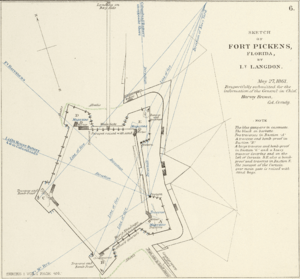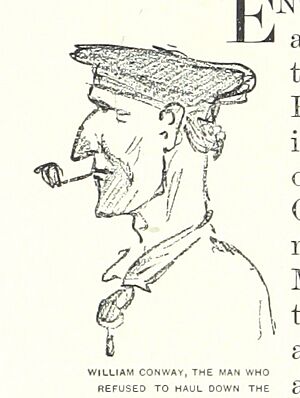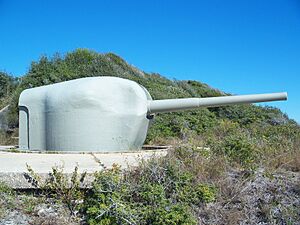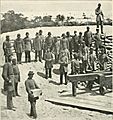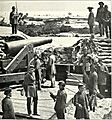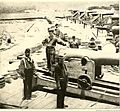Fort Pickens facts for kids
Quick facts for kids |
|
|
Fort Pickens
|
|

Panorama of Fort Pickens
|
|
| Lua error in Module:Location_map at line 420: attempt to index field 'wikibase' (a nil value). | |
| Nearest city | Pensacola Beach, Florida |
|---|---|
| Area | 850 acres (340 ha) |
| Built | 1834 |
| NRHP reference No. | 72000096 |
| Added to NRHP | May 31, 1972 |
Fort Pickens is a historic military fort located on Santa Rosa Island near Pensacola, Florida. It was named after American Revolutionary War hero Andrew Pickens. This fort was the largest of four forts built to protect Pensacola Bay and its important navy yard. Completed in 1834, Fort Pickens was one of the few forts in the Southern United States that stayed under Union control throughout the American Civil War. It was used by the military until 1947. Today, Fort Pickens is part of the Gulf Islands National Seashore and is managed by the National Park Service.
Contents
- Building Fort Pickens: A Strong Design
- Fort Pickens History: From Building to Battles
- Fort Pickens in the Civil War
- Indian Wars: Geronimo's Imprisonment
- Endicott Era: Modernizing the Fort
- Post World War I: New Defenses
- World War II: Protecting the Coast
- Nearby Fortifications: Other Pensacola Bay Forts
- Images for kids
Building Fort Pickens: A Strong Design
Fort Pickens was part of a plan called the "Third System of Fortifications." This plan aimed to build stronger, more modern forts across the United States. The fort was designed in a five-sided shape, like a pentagon. Its western walls were made wider to allow cannons to fire across a large area of the bay.
To protect against attacks from land, the fort had a special ditch called a counterscarp on its east side. This ditch would make it harder for enemies to reach the fort. The western parts of the fort also had hidden rooms with explosives. These could be set off as a last defense if invaders got too close.
Fort Pickens History: From Building to Battles
After the War of 1812, the United States decided to make all its major ports safer. A French engineer named Simon Bernard was chosen to design Fort Pickens. Construction of the fort began in 1829 and finished in 1834. Workers used an amazing 21.5 million bricks to build it! Many of these workers were enslaved people. Colonel William Henry Chase of the U.S. Army Corps of Engineers oversaw the building. Interestingly, during the Civil War, Colonel Chase joined the Confederacy and led their troops in Florida.
Fort Pickens was the biggest of several forts built to protect Pensacola Harbor. It worked with Fort Barrancas, Fort McRee, and the Navy Yard. Located at the very end of Santa Rosa Island, Fort Pickens guarded the island and the main entrance to the harbor.
Fire of 1858: A Community Effort
On January 20, 1858, a large fire broke out at Fort Pickens. The crew and boats from a nearby ship, the USCS Robert J. Walker, quickly helped fight the flames. They were joined by a team from another ship, the USCS Varina. The next day, the captain of the Robert J. Walker received a thank you from Captain John Newton, who was in charge of Pensacola's harbor. He recognized the important help given by the ship's crew.
Fort Pickens in the Civil War
By the time the American Civil War began, Fort Pickens had not been used much since the Mexican–American War. Even though it was old, Lieutenant Adam J. Slemmer, who was in charge of U.S. forces at Fort Barrancas, believed Fort Pickens was the best place to defend. He decided to leave Fort Barrancas after his guards stopped a group of local civilians trying to take over the fort on January 8, 1861. Some historians say these were the very first shots of the Civil War.
On January 10, 1861, the same day Florida decided to leave the Union, Slemmer destroyed over 20,000 pounds of gunpowder at Fort McRee. He then made the cannons at Fort Barrancas unusable and moved his small group of 51 soldiers and 30 sailors to Fort Pickens. Slemmer bravely refused demands to surrender from Colonel William Henry Chase of the Florida militia. Colonel Chase had actually helped design and build Fort Pickens years earlier! Slemmer defended the fort until more Union troops arrived on April 11, 1861.
Confederate forces attacked Fort Pickens on October 9, 1861, in the Battle of Santa Rosa Island. About a thousand Confederate soldiers landed four miles away and attacked from the east. But the Union soldiers at Fort Pickens fought back with cannons and gunfire. The Confederates were forced to retreat, with about 90 soldiers injured or killed.
Bombardments: Union Attacks on Confederate Forts
As tensions grew in Pensacola, the Confederates took control of Fort McRee and Fort Barrancas. The Union forces then decided to attack these Confederate forts with their own cannons. On November 22, two Union warships, the Niagara and the Richmond, sailed into the bay. The attack lasted two days, and it went well for the Union. Fort McRee was almost completely destroyed. The nearby town of Warrington and the Navy Yard were also ruined.
A second attack, meant to finish off the Confederates, happened on New Year's Day 1862. Fort McRee was nearly destroyed again, and any buildings close to Fort Barrancas were burned down.
Confederate Surrender: Fort Pickens Stands Strong
The Confederates began to run low on supplies and their spirits were low. They started to doubt their chances of winning the Battle of Pensacola. Eventually, the Battle of Mobile Bay drew the last of the Southern forces away to Alabama. On May 10, 1862, the remaining Confederates at Pensacola surrendered to Fort Pickens.
Fort Pickens was one of only four Southern forts that stayed in Union hands throughout the entire Civil War. The others were Fort Taylor in Key West, Florida, Fort Jefferson in the Dry Tortugas, and Fort Monroe in Virginia.
Indian Wars: Geronimo's Imprisonment
After the Indian Wars in the Western United States, some Native American leaders were sent to the East Coast as prisoners. From October 1886 to May 1887, Geronimo, a famous Apache war chief, was held prisoner at Fort Pickens. Several of his warriors were also imprisoned there. Their families were kept at Fort Marion in St. Augustine, Florida.
Endicott Era: Modernizing the Fort
In the late 1890s and early 1900s, the Army built new gun batteries at Fort Pickens. These batteries were part of a program started by the Endicott Board, a group led by Secretary of War William C. Endicott. Instead of many cannons packed into a thick-walled fort, these new batteries were spread out. They were hidden behind concrete walls that blended with the ground. These new, accurate, long-range weapons meant that cannons no longer needed to be grouped together as they were in older forts.
Battery Pensacola was built inside the walls of Fort Pickens. Other similar concrete batteries were built nearby as separate facilities. The remains of these later batteries are also part of the Gulf Islands National Seashore. During World War I, some older weapons were reused. For example, Battery Cooper's 6-inch guns were removed in 1917.
When these new Endicott Batteries were built, little thought was given to keeping the old fort as it was. Parts of the fort's south wall and officers' quarters were torn down. Sections of the southeast wall were also removed. These changes were made so that the large 12-inch guns of Battery Pensacola could fire without anything blocking their path.
| Battery Name | Constructed | Armament | Carriage Type |
|---|---|---|---|
| Battery Pensacola | 1899 | x2 12" | Disappearing |
| Battery Trueman | 1905 | x2 3" | Barbette |
| Battery Payne | 1904 | x2 3" | Barbette |
| Battery Cullum | 1898 | x2 10" | Disappearing |
| Battery Sevier | 1898 | x2 10" | Disappearing |
| Battery Cooper | 1904 | x2 6" | Disappearing |
| Battery Van Swearingen | 1898 | x2 4.7" | Barbette |
On June 20, 1899, a fire in Bastion D of Fort Pickens reached the bastion's magazine, which held 8,000 pounds of gunpowder. The explosion that followed killed one soldier and completely destroyed Bastion D. The blast was so powerful that bricks from Bastion D landed across the bay at Fort Barrancas, more than 1.5 miles away! The damage was mostly limited to Bastion D. Sections of the walls were also removed to make it easier to bring mechanical equipment for Battery Pensacola into the fort.
Post World War I: New Defenses
GPF Battery
After World War I, plans were made to add new gun mounts, starting in 1937. Four 155mm GPF guns were placed around Battery Cooper in 1942. Two guns were in front, and one on each side. These guns used concrete rings to help with aiming, which you can still see today. The guns themselves have since been removed. This 155mm battery used Battery Cooper's storage rooms, communication systems, and other support buildings.
Battery Langdon
Battery Langdon was built in 1923. It had 12-inch guns that were meant to work with the guns already at Battery Pensacola. At first, the guns were out in the open, but their ammunition and control center were kept inside a strong dirt mound between the guns. Later, in 1943, concrete shelters were built around the guns.
World War II: Protecting the Coast
During World War II, the U.S. Navy was very interested in Fort Pickens. They decided the fort's defenses needed to be made even stronger. A specific threat was German U-Boats, which were already operating in the Gulf of Mexico.
Battery 234: Modern Guns
One new addition to Fort Pickens's defense was Battery 234. It was designed to work with Battery 233, located across the bay on Perdido Key. Many similar batteries were built across the country. They were meant to replace older, lighter artillery. Both batteries were designed to hold two 6-inch guns inside strong steel shelters. The command center for these batteries was buried under an artificial hill to protect it from air attacks. The guns were never installed during the war. However, in 1976, the Smithsonian Institution donated two guns, which are now on display there.
Battery Langdon (1943): Bomb-Proof Shelter
To protect against German dive bombers, Battery Langdon was given a concrete shelter in 1943. The 12-inch guns that were already there were kept. But 17 feet of concrete was added to create a bomb-proof bunker. This bunker was then covered with sand and dirt to create an artificial hill around the battery. This gave it even more protection.
Nearby Fortifications: Other Pensacola Bay Forts
Fort McRee was built on Perdido Key, across Pensacola Pass from Fort Pickens. Union forces left it in January 1861, and it was taken over by Florida and Alabama militia. It was badly damaged by Union attacks later that year during the Civil War. After Confederate forces left, Fort McRee remained in ruins for about 30 years. Even though it was improved in the late 1800s before the Spanish–American War, a hurricane on September 26–27, 1906, destroyed most of the newer buildings. After the hurricane, only a small staff stayed there to guard the site. Because it was hard to reach, Fort McRee was left to the weather. Storms and erosion have worn away the site. Today, only a few scattered foundations remain.
Fort Barrancas was built around older Spanish forts from the 1600s and 1700s. Its related Advanced Redoubt is about a mile northwest. Both are located across Pensacola Bay on what is now Naval Air Station Pensacola. When Union forces left Fort McRee in 1861, they also left Fort Barrancas, moving back to Fort Pickens. This fort was also taken over by Florida and Alabama militia, who then joined the Confederate forces. In May 1862, after hearing that the Union Army had captured New Orleans, Confederate troops left Pensacola and Fort Barrancas. The fort then returned to Union control.
Images for kids
-
The 4.7" Armstrong Guns, manufactured in Great Britain, were mounted at Battery Van Swearingen



